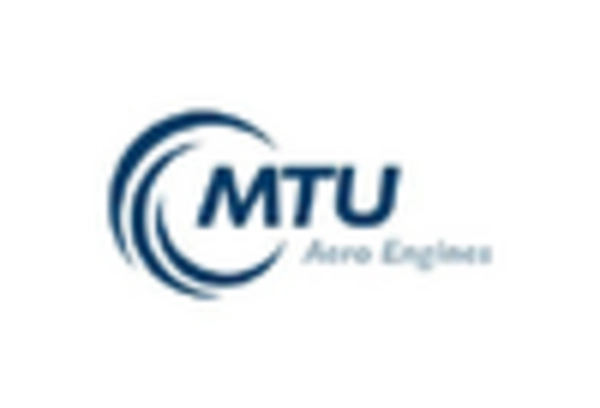The LEAP Engine Market is characterized by a dynamic competitive landscape, driven by technological advancements and increasing demand for fuel-efficient engines. Major players such as General Electric (US), Rolls-Royce (GB), and Safran (FR) are at the forefront, each adopting distinct strategies to enhance their market positioning. General Electric (US) focuses on innovation through its digital twin technology, which optimizes engine performance and maintenance. Meanwhile, Rolls-Royce (GB) emphasizes sustainability, investing heavily in hybrid-electric propulsion systems to meet evolving regulatory standards. Safran (FR) is enhancing its operational efficiency by integrating advanced manufacturing techniques, thereby reducing production costs and improving delivery timelines. Collectively, these strategies contribute to a competitive environment that prioritizes technological leadership and operational excellence.
Key business tactics within the LEAP Engine Market include localizing manufacturing and optimizing supply chains to enhance responsiveness to market demands. The market structure appears moderately fragmented, with several key players exerting substantial influence. This fragmentation allows for a variety of competitive strategies, as companies seek to differentiate themselves through innovation and customer service. The collective influence of these players shapes a landscape where agility and adaptability are paramount, particularly in response to shifting consumer preferences and regulatory pressures.
In November 2025, General Electric (US) announced a partnership with a leading aerospace manufacturer to co-develop next-generation LEAP engines that utilize sustainable aviation fuel (SAF). This strategic move underscores GE's commitment to sustainability and positions the company to capitalize on the growing demand for eco-friendly aviation solutions. By aligning with a partner that possesses complementary capabilities, GE enhances its innovation potential while addressing environmental concerns that are increasingly important to stakeholders.
In October 2025, Rolls-Royce (GB) unveiled its latest hybrid-electric engine prototype, marking a significant milestone in its sustainability strategy. This development not only showcases Rolls-Royce's technological prowess but also reflects its proactive approach to meeting future regulatory requirements. The hybrid-electric engine is expected to reduce emissions by up to 30%, thereby appealing to airlines seeking to enhance their environmental credentials. This innovation could potentially reshape market dynamics as competitors strive to keep pace with Rolls-Royce's advancements.
In September 2025, Safran (FR) completed the acquisition of a small aerospace technology firm specializing in additive manufacturing. This acquisition is strategically important as it allows Safran to enhance its production capabilities and reduce lead times for engine components. By integrating advanced manufacturing technologies, Safran positions itself to improve its competitive edge in a market that increasingly values efficiency and speed. This move may also encourage other players to explore similar strategies to remain competitive in the evolving landscape.
As of December 2025, current competitive trends in the LEAP Engine Market are heavily influenced by digitalization, sustainability, and the integration of artificial intelligence (AI) into engine design and maintenance. Strategic alliances are becoming increasingly vital, as companies recognize the need to pool resources and expertise to drive innovation. The competitive differentiation is likely to evolve from traditional price-based competition to a focus on technological innovation, reliability, and sustainable practices. This shift suggests that companies that prioritize R&D and sustainable solutions will be better positioned to thrive in the future.

















Leave a Comment